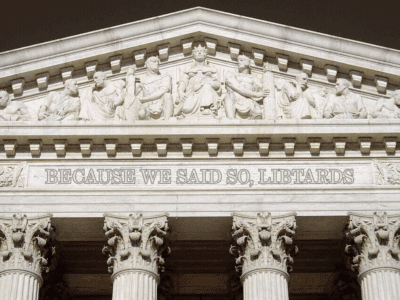Wetlands, the Clean Water Act & the Supreme Court: the Sacketts Return to Washington
Justices Grant Review (Again) in the Sacketts’ Longstanding Wetlands Battle With the Government

This week the U.S. Supreme Court agreed to hear the case of Sackett v. USEPA, No. 21-454, an important appeal involving the scope of federal authority to regulate wetlands under the Clean Water Act.
If the Sackett litigation sounds familiar, it should: the case has been pending for well over a decade, and this is the Sacketts’ second trip to the Supreme Court in that very same lawsuit.
Earlier this month, Legal Planet colleague Dan Farber wrote a typically-thoughtful post on this site aptly titled, “The Quagmire of Clean Water Act Jurisdiction.” I won’t retread that ground, except to note the following:
Congress is an un-indicted co-conspirator in this saga for having created the legal mess involving the jurisdictional boundaries of the CWA in the first place. In the CWA, Congress indicated that federal jurisdiction to protect water quality and wetlands in the U.S. is limited to “navigable waters.” But it simply (and unhelpfully) defined “navigable waters” as “waters of the United States.” Courts, federal regulators, states and members of the regulated community have all spent the last half-century struggling mightily to understand exactly what those terms mean, and how broadly or narrowly federal CWA authority extends.
The Supreme Court has addressed the proper interpretation of the CWA’s jurisdictional scope in a number of decisions over the past 50 years. The most recent Supreme Court case on that issue in the wetlands context is the justices’ infamous 2006 non-decision in Rapanos v. United States. In a case involving the extent of the government’s authority to regulate wetlands under section 404 of the CWA, the Court was unable to reach a decision on the merits. As Dan notes in his previous post, Justice Scalia wrote a plurality opinion in Rapanos arguing that CWA jurisdiction should only apply to relatively few wetlands, along with major rivers, lakes and streams. The four progressive justices on the Court, by contrast, opined that the government’s then-expansive interpretation of CWA permit jurisdiction passed legal muster. Justice Kennedy wrote his own opinion in Rapanos asserting that wetlands having a “significant nexus” to traditional navigable waters came within the fed’s regulatory authority over wetlands.
Since then, most lower courts have relied on the Kennedy “significant nexus” test as the law of the land, figuring that if it seemed right to Kennedy and acceptable to the four progressive justices, that was good enough for them.
But there was one other opinion in Rapanos that bears mention: Chief Justice Roberts wrote in a concurring opinion that reviewing courts, members of the regulated community and environmentalists would all greatly benefit from a federal regulation that interprets and clarifies the CWA’s vague “navigable waters” provision. Roberts practically begged the Executive Branch to promptly initiate a rulemaking process with that goal in mind.
No such luck. Dragging its feet, the George W. Bush administration belatedly commenced of a CWA rulemaking proceeding, but let it die on the vine. President Obama’s administration similarly delayed any action for years, only proposing its so-called “Waters of the United States” (WOTUS) CWA jurisdictional rule near the end of Obama’s second term.
The WOTUS rule never went into effect. Multiple lawsuits were filed challenging it, and federal courts quickly enjoined the rule’s implementation. That, in turn, prompted the Trump Administration’s attempted repeal of the WOTUS rule, which Trump tried to replace with his own jurisdictional rule–one hewing to the narrow standard Justice Scalia proposed in Rapanos. The Trump rule, like the WOTUS rule before it, was promptly challenged in, and enjoined by, the courts. Now the Biden administration has issued a new order repealing the Trump rule, while delaying promulgation of its own regulation defining the CWA’s jurisdictional reach. And so it goes.
The U.S. Supreme Court has apparently lost its patience in waiting for the Executive Branch to clarify the jurisdictional scope of the CWA. And that’s where the Sackett litigation comes in.
Michael and Chantell Sackett are an Idaho couple who for years have been attempting to develop their rural Idaho property without having to obtain a federal dredge-and-fill permit under section 404 of the CWA. Government regulators assert that a portion of the Sackett’s property contemplated for development is indeed wetlands requiring a CWA permit. When the Sacketts began some preconstruction work by filling their lot with dirt and rock, USEPA officials issued an administrative “compliance order” directing them to remove the fill and restore the lot to its original condition, upon pain of civil penalties if they failed to do so. After the Sacketts sought and were denied an administrative hearing before the EPA, they filed a lawsuit against the government in federal court. There they claimed that EPA’s issuance of the compliance order was arbitrary and capricious and violated their right to due process. After the district court and Ninth Circuit Court of Appeals ruled against them, the Sacketts–represented by the Pacific Legal Foundation–sought and obtained review by the U.S. Supreme Court. The Court in 2012 ruled unanimously in favor of the Sacketts, finding that under the circumstances they were within their rights in filing a lawsuit challenging the propriety of EPA’s compliance order, and were not required to wait until the EPA pursued its own CWA enforcement action against them. The justices remanded the case back to the lower courts.
Over the following decade, the Sackett litigation has again slowly worked its way up the federal court ladder–this time on the merits of the Sacketts’ claim that their property does not contain wetlands under a proper application of the CWA. Last year, the Ninth Circuit reached the merits of the Sacketts’ case, relying on Justice Kennedy’s concurring opinion in Rapanos to conclude that the Sackett lot is indeed subject to EPA’s wetlands permit jurisdiction under the CWA.
Undeterred, the Sacketts and their PLF counsel again petitioned the Supreme Court for review, contending that the Scalia plurality view of CWA jurisdiction articulated in Rapanos represents the proper standard. The justices granted the Sacketts’ second petition on January 24th. The case is likely to be set for argument next fall, with a decision issued a few months later.
So what do these developments mean and portend for wetlands jurisdiction under the CWA?
First, it appears that Chief Justice Roberts–and his fellow justices–have grown impatient with the Executive Branch’s inability to issue and implement a regulation that provides affected parties clear direction as to the CWA’s jurisdictional limits. Exasperated with regulatory inaction, the justices have signaled their readiness to resolve the jurisdictional question themselves. They did so when they rewrote the “Question Presented” in the Sackett’s petition to frame the issue before them as: “[w]hether the Ninth Circuit set forth the proper test for determining whether wetlands are `waters of the United States’ under the Clean Water Act.”
Since the Supreme Court’s 4-1-4 vote in the 2006 Rapanos case, the makeup of the Court has changed dramatically–from an evenly-balanced group of conservative and progressive justices to one reflecting a 6-3 majority of conservatives. The three justices who joined Scalia’s Rapanos opinion in 2006 remain on the court. Meanwhile, three of the four progressive justices who dissented from Scalia’s Rapanos opinion no longer there. And in a CWA jurisdiction case he ruled in while on the D.C. Circuit Court of Appeals, Justice Kavanaugh indicated that he agrees with the Scalia opinion.
As the adage goes, “the Supreme Court does not take cases to affirm” lower court decisions. In recent years, the justices have demonstrated particular antipathy towards the environmental rulings of the Ninth Circuit.
In sum, it seems likely the Supreme Court will reverse the Ninth Circuit and vote in favor of the Sacketts a second time. More importantly for the rest of us, the justices appear ready to fashion their own, definitive rule regarding the jurisdictional reach of the CWA. And that Court-crafted rule will most likely reduce dramatically the scope of the federal government’s ability to protect the nation’s wetlands and water quality in the future.
Reader Comments
3 Replies to “Wetlands, the Clean Water Act & the Supreme Court: the Sacketts Return to Washington”
Comments are closed.






As the saying goes, everything is a nail to a hammer. The Sacketts get to drop the hammer twice on EPA via the judicial system. It seems that this is inevitable given the myriad legal challenges to EPA’s proposed WOTUS rule. Since the EPA cannot promulgate a proposed rule without significant delay, it seems likely the path of least resistance is to allow the Supreme Court to decide once and for all the reach of EPA to protect the nation’s navigable waters.
What about climate change in the water? There is currently narrow regulation as to the effect of climate change in the water. The rule of law is quite simple, if you discharge any type of pollutant into a water, then you must have a permit. The Clean Water Act is the highlighted law and a state or federal agency will issue a permit to those who discharge a pollutant into the water. But what if the discharge is just warmer water? Are certifying authorities to issue permits to those who are merely warming up the water?
The main issue here, of course, is that the warmer water affects the aquatic life and plants that may be affected by this new form of climate in the water. That is not to say that I do not notice that the warmer water is a product of a facility that is producing for the people of that region and beyond. It could be that a hydroelectric utility is generating power for a city or town with minimum effects to the environment. It could be that the hydroelectric utility is holding itself out as a sustainable plant and that the warmer water is merely a non-issue.
It could be that the warmer water is only affecting a certain section of a river. Then the water temperature goes back to what it used to be about a mile down the river. Should this activity be regulated or should it be permitted? Essentially, no facility can actually function without a permit should this scenario be realized. The utility can argue that it is only warming up the water during certain times of the day and the rest of the day, the water temperature remains unaffected.
Clean Water Act defines “pollutant,” to include, among other things, “heat.” and Temperature-impaired waterbodies are addressed through TMDLs. So climate change in the water (never heard of that phrasing before) is addressed at the federal, state, and local level, as well as through permit enforcement.